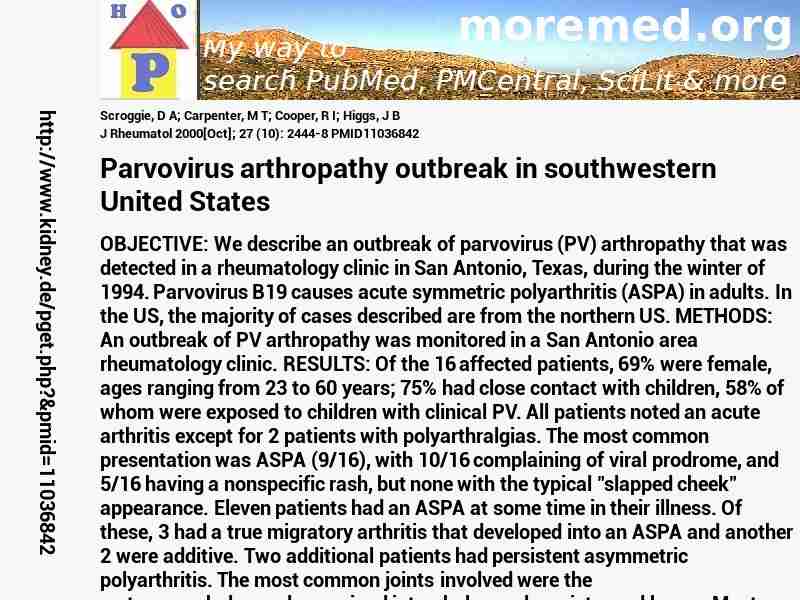
|
http://scihub22266oqcxt.onion/

11036842!�!11036842
|  
Deprecated: Implicit conversion from float 211.6 to int loses precision in C:\Inetpub\vhosts\kidney.de\httpdocs\pget.php on line 534
Deprecated: Implicit conversion from float 211.6 to int loses precision in C:\Inetpub\vhosts\kidney.de\httpdocs\pget.php on line 534
Warning: imagejpeg(C:\Inetpub\vhosts\kidney.de\httpdocs\phplern\11036842.jpg): Failed to open stream: No such file or directory in C:\Inetpub\vhosts\kidney.de\httpdocs\pget.php on line 117
 J+Rheumatol 2000 ; 27 (10): 2444-8 J+Rheumatol 2000 ; 27 (10): 2444-8
Nephropedia Template TP
gab.com Text
Twit Text FOAVip
Twit Text #
English Wikipedia
|
Parvovirus arthropathy outbreak in southwestern United States #MMPMID11036842Scroggie DA; Carpenter MT; Cooper RI; Higgs JBJ Rheumatol 2000[Oct]; 27 (10): 2444-8 PMID11036842show ga
OBJECTIVE: We describe an outbreak of parvovirus (PV) arthropathy that was detected in a rheumatology clinic in San Antonio, Texas, during the winter of 1994. Parvovirus B19 causes acute symmetric polyarthritis (ASPA) in adults. In the US, the majority of cases described are from the northern US. METHODS: An outbreak of PV arthropathy was monitored in a San Antonio area rheumatology clinic. RESULTS: Of the 16 affected patients, 69% were female, ages ranging from 23 to 60 years; 75% had close contact with children, 58% of whom were exposed to children with clinical PV. All patients noted an acute arthritis except for 2 patients with polyarthralgias. The most common presentation was ASPA (9/16), with 10/16 complaining of viral prodrome, and 5/16 having a nonspecific rash, but none with the typical "slapped cheek" appearance. Eleven patients had an ASPA at some time in their illness. Of these, 3 had a true migratory arthritis that developed into an ASPA and another 2 were additive. Two additional patients had persistent asymmetric polyarthritis. The most common joints involved were the metacarpophalangeals, proximal interphalangeals, wrists, and knees. Most patients' syndromes lasted < 6 weeks, but 3 patients had symptoms that lasted longer than 6 months. Eight of 10 had elevated erythrocyte sedimentation rate. Rheumatoid factor was detected in 3 patients and antinuclear antibody in 2. All patients were treated symptomatically with nonsteroidal antiinflammatory drugs and a few also received low dose corticosteroids. Because of suspicious clinical presentations, 2 patients were presumed to have gonococcal arthritis before PV titers were available. CONCLUSION: This is the first large series on adults with PV arthropathy reported in the southern US. In contrast to the usual features of ASPA, the outbreak appears unique in that almost 40% of cases presented with a true migratory arthritis.|*Disease Outbreaks[MESH]|Adult[MESH]|Antibodies, Antinuclear/blood[MESH]|Antibodies, Viral/immunology[MESH]|Antigens, Viral/blood[MESH]|Arthritis, Infectious/blood/*epidemiology/etiology[MESH]|Blood Sedimentation[MESH]|Female[MESH]|Humans[MESH]|Immunoglobulin G/blood[MESH]|Immunoglobulin M/blood[MESH]|Joints/pathology[MESH]|Male[MESH]|Middle Aged[MESH]|Parvoviridae Infections/blood/complications/*epidemiology[MESH]|Parvovirus/immunology/*isolation & purification[MESH]|Retrospective Studies[MESH]|Rheumatoid Factor/blood[MESH]
  
DeepDyve
Pubget Overpricing | 
|